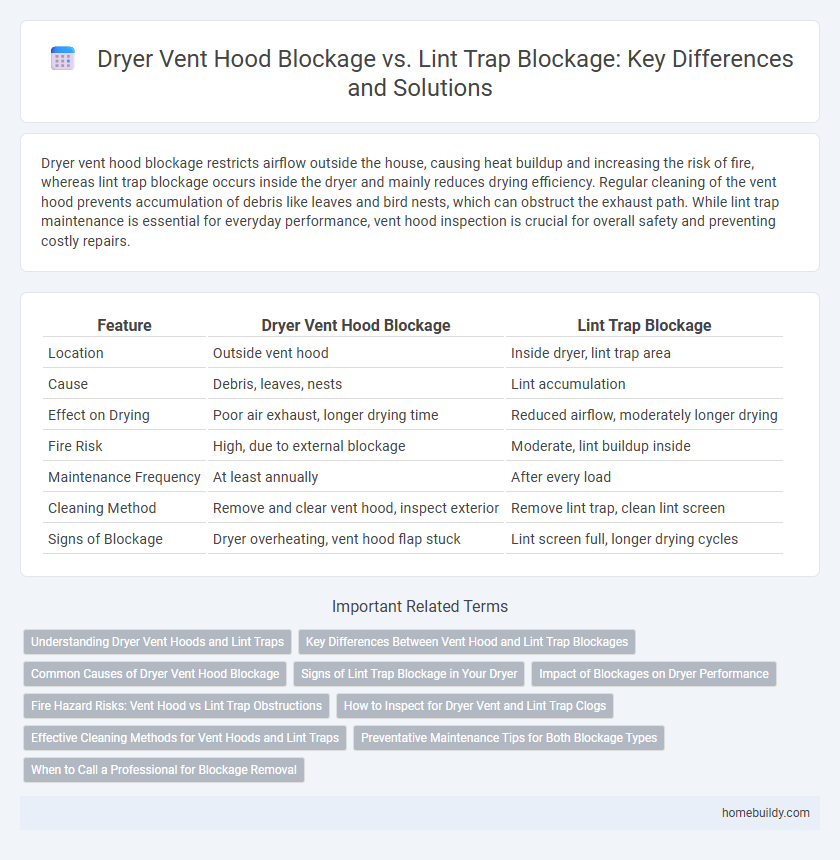Dryer vent hood blockage restricts airflow outside the house, causing heat buildup and increasing the risk of fire, whereas lint trap blockage occurs inside the dryer and mainly reduces drying efficiency. Regular cleaning of the vent hood prevents accumulation of debris like leaves and bird nests, which can obstruct the exhaust path. While lint trap maintenance is essential for everyday performance, vent hood inspection is crucial for overall safety and preventing costly repairs.
Table of Comparison
| Feature | Dryer Vent Hood Blockage | Lint Trap Blockage |
|---|---|---|
| Location | Outside vent hood | Inside dryer, lint trap area |
| Cause | Debris, leaves, nests | Lint accumulation |
| Effect on Drying | Poor air exhaust, longer drying time | Reduced airflow, moderately longer drying |
| Fire Risk | High, due to external blockage | Moderate, lint buildup inside |
| Maintenance Frequency | At least annually | After every load |
| Cleaning Method | Remove and clear vent hood, inspect exterior | Remove lint trap, clean lint screen |
| Signs of Blockage | Dryer overheating, vent hood flap stuck | Lint screen full, longer drying cycles |
Understanding Dryer Vent Hoods and Lint Traps
Dryer vent hoods and lint traps serve distinct roles in dryer airflow management, with vent hoods facilitating external exhaust and lint traps capturing lint inside the dryer. Blockages in dryer vent hoods often involve external debris like leaves or bird nests, causing reduced airflow and increased drying time. Lint trap blockages primarily result from accumulated lint fibers, posing a fire hazard and decreasing dryer efficiency, emphasizing the importance of regular cleaning for both components.
Key Differences Between Vent Hood and Lint Trap Blockages
Dryer vent hood blockages occur outside the dryer and often involve debris like leaves, nesting materials, or external lint buildup, restricting airflow and increasing fire risk. Lint trap blockages happen inside the dryer, capturing lint from clothes, which, when clogged, reduce drying efficiency and can cause overheating. Key differences include location of blockage, type of debris involved, and impact on dryer performance and safety.
Common Causes of Dryer Vent Hood Blockage
Dryer vent hood blockage commonly occurs due to accumulated lint, debris, and outdoor elements such as leaves and bird nests obstructing airflow. Unlike lint trap blockage, which results from lint buildup inside the dryer's filter, vent hood blockages happen externally and can cause significant airflow restriction, increasing drying time and fire risk. Regular cleaning and inspection of the vent hood and surrounding areas are essential to prevent these blockages and maintain dryer efficiency.
Signs of Lint Trap Blockage in Your Dryer
Signs of lint trap blockage in your dryer include longer drying times, overheating, and a burning smell during operation. Reduced airflow caused by accumulated lint can lead to excessive heat buildup, increasing fire risk and energy consumption. Regularly cleaning the lint trap enhances dryer efficiency and minimizes the chances of appliance damage or safety hazards.
Impact of Blockages on Dryer Performance
Dryer vent hood blockage significantly reduces airflow, causing longer drying times and increased energy consumption, while lint trap blockage primarily restricts lint collection but can also impede airflow if not cleaned regularly. Accumulated debris in the vent hood creates heat buildup, risking potential fire hazards and mechanical wear on the dryer's motor. Maintaining clear dryer vent hoods ensures optimal drying efficiency and safety, complementing routine lint trap cleaning.
Fire Hazard Risks: Vent Hood vs Lint Trap Obstructions
Dryer vent hood blockages pose a significantly higher fire hazard risk compared to lint trap obstructions due to restricted airflow causing heat buildup in the vent system. While lint trap clogs primarily reduce dryer efficiency, accumulated debris in the vent hood can ignite, leading to dangerous chimney fires and property damage. Regular cleaning of both the lint trap and dryer vent hood is essential to prevent fire hazards and maintain safe dryer operation.
How to Inspect for Dryer Vent and Lint Trap Clogs
To inspect for dryer vent and lint trap clogs, first disconnect the dryer from the power source and remove the lint trap to check for visible lint buildup. Use a flashlight and a flexible vent cleaning brush or vacuum attachment to inspect and clean inside the vent hose and vent hood outside the house. Regular inspection and cleaning of both the lint trap and vent hood prevent airflow obstruction, reducing fire risk and improving dryer efficiency.
Effective Cleaning Methods for Vent Hoods and Lint Traps
Effective cleaning methods for dryer vent hoods include removing accumulated debris, such as leaves and dust, using a vacuum or brush designed to reach deep inside the vent. For lint traps, regularly removing lint after each drying cycle and washing the trap with soap and water monthly prevents clogs and ensures optimal airflow. Combining these cleaning practices reduces fire hazards and improves dryer efficiency.
Preventative Maintenance Tips for Both Blockage Types
Regular cleaning of dryer vent hoods and lint traps is essential to prevent airflow obstruction and reduce fire risks. Inspect vent hoods for debris, bird nests, or ice buildup seasonally while removing lint from traps after each drying cycle. Use a vent brush and vacuum to thoroughly clear vents periodically, ensuring efficient dryer performance and extended appliance lifespan.
When to Call a Professional for Blockage Removal
Dryer vent hood blockage often occurs outside the dryer and affects airflow, while lint trap blockage happens inside the machine and reduces drying efficiency. Call a professional for vent hood blockage removal when visible lint buildup restricts airflow or causes longer drying times despite clean lint traps. Persistent odors, overheating, or frequent dryer malfunctions also indicate the need for expert inspection and cleaning to prevent fire hazards.
Dryer vent hood blockage vs lint trap blockage Infographic

 homebuildy.com
homebuildy.com